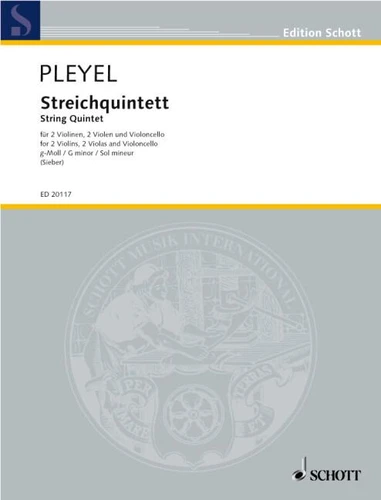Edition Schott
Quintette à cordes en sol mineur. pour 2 violons, 2 altos et violoncelle (1785), BEN 272. BEN 272. 2 violins, 2 violas and cello. Partition et parties.
Par : Formats :
- Paiement en ligne :
- Livraison à domicile ou en point Mondial Relay indisponible
- Retrait Click and Collect en magasin gratuit
- Réservation en ligne avec paiement en magasin :
- Indisponible pour réserver et payer en magasin
- Nombre de pages82
- Poids0.329 kg
- Dimensions23,1 cm × 30,3 cm × 0,0 cm
- ISBN979-0-001-14649-4
- EAN9790001146494
- Date de parution01/01/2007
- ÉditeurSchott
- EditeurTilman Sieber
Résumé
The Quintet in G minor belongs to the first group of three quintets written by Ignaz Pleyel in 1785 and published for the first time in 1786. Of all his quintets, it was the most frequently published one and was available in various editions even during Pleyel's lifetime. The modern character of this piece shows in the 'new kind' of compositional technique and elaboration of the themes, as presented by Joseph Haydn for the first time in 1781 in his String Quartets Op.
33. As with Haydn, the modern compositional style shows in the thematic work of the development which is mainly derived from the main theme. Particularly impressive is the elaboration of the theme by imitation, sequencing, shortening, rhythmic and tonal changes as well as by inversion. Instrumentation : 2 violins, 2 violas and cello BEN 272
33. As with Haydn, the modern compositional style shows in the thematic work of the development which is mainly derived from the main theme. Particularly impressive is the elaboration of the theme by imitation, sequencing, shortening, rhythmic and tonal changes as well as by inversion. Instrumentation : 2 violins, 2 violas and cello BEN 272
The Quintet in G minor belongs to the first group of three quintets written by Ignaz Pleyel in 1785 and published for the first time in 1786. Of all his quintets, it was the most frequently published one and was available in various editions even during Pleyel's lifetime. The modern character of this piece shows in the 'new kind' of compositional technique and elaboration of the themes, as presented by Joseph Haydn for the first time in 1781 in his String Quartets Op.
33. As with Haydn, the modern compositional style shows in the thematic work of the development which is mainly derived from the main theme. Particularly impressive is the elaboration of the theme by imitation, sequencing, shortening, rhythmic and tonal changes as well as by inversion. Instrumentation : 2 violins, 2 violas and cello BEN 272
33. As with Haydn, the modern compositional style shows in the thematic work of the development which is mainly derived from the main theme. Particularly impressive is the elaboration of the theme by imitation, sequencing, shortening, rhythmic and tonal changes as well as by inversion. Instrumentation : 2 violins, 2 violas and cello BEN 272

